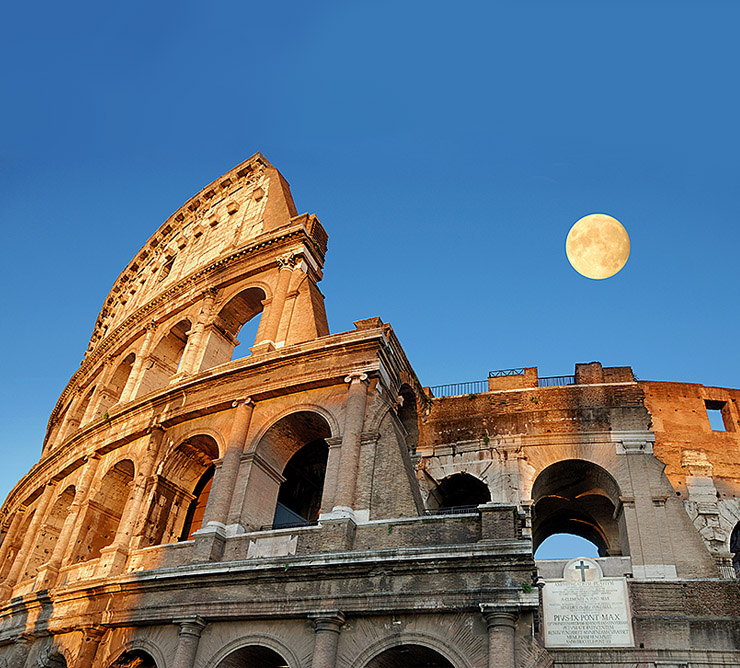Il Parco archeologico del Colosseo amplia la propria offerta al pubblico con un biglietto dedicato alla visita esclusiva del Foro Romano-Palatino e Fori Imperiali, che garantirà l’accesso anche a tutti i siti SUPER (Casa di Augusto, il Tempio di Romolo, Santa Maria Antiqua, Oratorio dei Quaranta Martiri, la Curia Iulia).
Con un solo biglietto puoi visitare il Foro Romano, il Palatino, i Fori Imperiali e il Carcere Mamertino
Accesso nell’area archeologica del Foro Romano/Palatino dall’ingresso dedicato sito in Clivo Argentario, e goditi l’Antica Roma senza fare la fila.
Accesso ai Fori Imperiali dalla Colonna Traiana, Via dei Fori Imperiali.
Per ascoltare l'audioguida sarà necessario scaricare la nostra App Vatican&Rome da App Store o Play Store
Luogo di scambio ed emissione del biglietto
Il biglietto è utilizzabile entro un mese dalla data di acquisto, è valido 1 giorno e comprende:
Gli accessi ai siti SUPER sono contingentati, in quanto conservano preziose pitture che potrebbero risentire di eccessivo affollamento. L'accesso ai siti SUPER sarà a partire dalle ore 9:30 fino ad 1 ora prima della chiusura.
*LA RIDUZIONE TRA i 18 e i 25 anni COMPIUTI (termina il giorno successivo al compimento del venticinquesimo anno di età) E' PREVISTA PER:
Siti Super visitabili clicca qui
Orari Foro Romano- Palatino e dei Fori Imperiali:
dal 1° gennaio al 29 febbraio 2024
tutti i giorni, dal lunedì alla domenica
9.00 – 16.30
Ultimo ingresso un’ora prima della chiusura
______________________________________________________
Dal 1° al 30 marzo 2024: 9.00 - 17.30
Dal 31 marzo al 30 settembre 2024: 9.00 - 19.15
Dal 1° al 26 ottobre 2024: 9:00 - 18.30
Dal 27 ottobre al 31 dicembre 2024: 9.00 - 16.30

The Palatine Museum is housed in the former convent of the Visitation Nuns, built in 1868 on the remains of Domitian's palace. Here in the 1930s, the new Palatine Antiques dealer was set up.
Many of the materials found in the numerous excavations that affected the Palatine Hill from the second half of the nineteenth century were transferred to the Museum of the Baths (of Diocletian).
After the Second World War, only a small part of the collection finally returned to the Palatine.
In the nineties of the last century the museum was reorganized and rearranged, improving its usability thanks also to multimedia installations.
The path is divided into two floors. On the ground floor, in rooms that retain the original structures of the pre-existing domus, the history of the hill is told from the origins of Rome to the advent of the Principality (1st century BC). On the first floor, among the many works on display, are the finds from the time of Augustus, the emperor who first changed the appearance of the Palatine, the mosaics and precious paintings from Nero's Domus Transitoria.
hide
Octavian was born on the Palatine Hill in 63 BC. and here he decides to place his residence, determining with this choice the destination as an imperial residence that the hill maintained until the fall of the empire. The house, which had many phases of life up to the Flavian era, was divided into a representative area, connected to the Templar area, and a private one, both characterized by mosaic floors and refined pictorial decoration.
Among the private rooms it is possible to admire the "Room of the masks", which evokes the complex facade of a theatrical scene, and the "Room of the pine festoons", both with simple but refined mosaic carpets in alternation of black and white.
The public part originally overlooked a porticoed peristyle and still retains pictorial decorations of the highest quality, perhaps the finest examples of late II Style Roman painting.
hide
This rich private domus of the first century BC, brought to light by nineteenth-century excavations, has been attributed to Livia on the basis of the name Iulia Augusta engraved on a lead pipe exhibited in the tablinum (reception room).
It consists of a quadrangular atrium on which there are four rooms paved in mosaic, with painted walls dating back to around 30 BC, considered among the most important testimonies of the II Style in Rome.
At the back, the tablinum opens in the center and two rooms symmetrically on the sides.
To the right of the atrium there is instead an environment interpreted as a triclinium (dining room).
hide
In the heart of Rome's imperial power: from Mamertine Prison to Colosseum

Discover the Eternal City aboard our unmistakable yellow Vatican&Rome Open Bus and explore new routes. Comfortably seated and with a multilingual audio guide system, you can look at the Eternal City from another point of view. An experience loved by adults and children.

Discover one of the largest Roman Catacombs and visit the Cathedral of Rome, the first of the four major papal basilicas and the oldest and most important basilica in the West. The Scala Santa and the Sancta Sanctorum, the Pope's private chapel until the Renaissance period.